
Most people are unaware that the swimming lagoons at Siloso Beach are actually quite rich in marine life. I've been wanting to explore some of these small islets off the main beach at low tide for quite some time, and besides, I also wanted to see if there was any noticeable increase in rubbish after ZoukOut.
I've got a soft spot for this place, even though it is really challenging. The water is extremely murky, and visibility is poor. If anyone tried scuba diving here, it would seriously be considered muck diving. Every step, no matter how gentle, stirs up a huge plume of sediment that instantly renders the water as opaque as a piece of cardboard. Unlike other shores that I've explored, there's no reef flat or otherwise flat areas of ground where marine creatures get trapped. There's only a gently sloping beach that suddenly drops off, and in some places, if you're not careful, you can suddenly plunge from your knees to waist-deep. The ground is mostly composed of a mixture of fine sand and mud that tends to crumble beneath your feet and slide down the slope, sending you into deeper water, whether you like it or not. Because of the profile of this shore, almost every fish, crab, prawn, or other motile organism that you spot will shoot straight for the murky depths before you can even think of switching on your camera.
And yet, with some patience, and a whole lot of luck, there's actually quite a fair bit to discover in such a difficult environment.
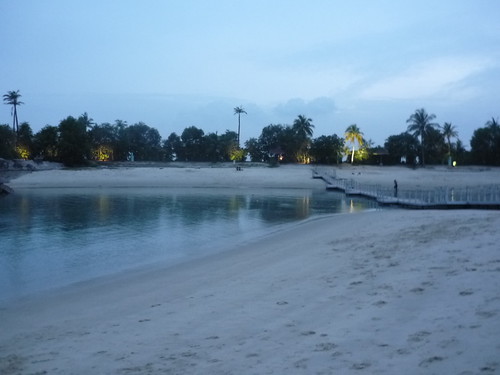
There are four of these artificial islets along Siloso Beach, and only one has a floating bridge that allows you to walk across. If I ever want to explore the other islets that are not connected to the main beach, I'll have to swim.
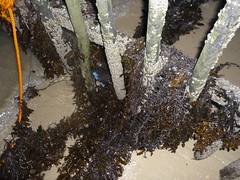

One section of Siloso Beach has been cordoned off for some sort of development works, and wooden barriers have been erected to prevent people from trespassing. These are now draped with Sargassum seaweed (Sargassum sp.).
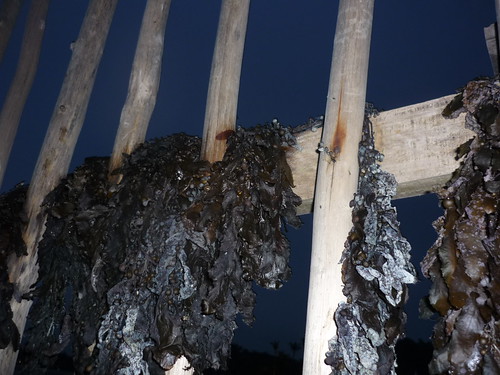
The tide must have been really high in order to hang all this seaweed above me.


These wooden poles have been here long enough to become encrusted with acorn barnacles (Balanus sp.) and colonised by periwinkles (F. Littorinidae). Purple climber crabs (Metopograpsus sp.) can be found here as well, but they're really skittish and good at hiding amongst the fronds of drying sargassum.
The floating bridge itself provides a good surface for a great deal of marine life to settle down and colonise.
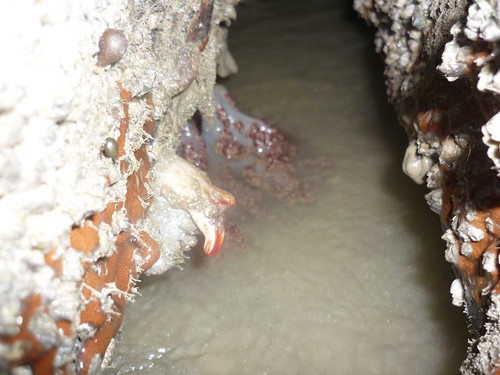
Here we have a thumbs-up sea squirt (Polycarpa sp.), and a pink flowery soft coral (F. Nephtheidae).
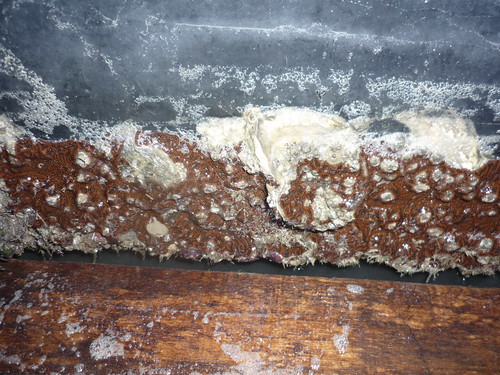
There's something reddish and flat growing on this part of the bridge. Could it be some sort of hard coral?
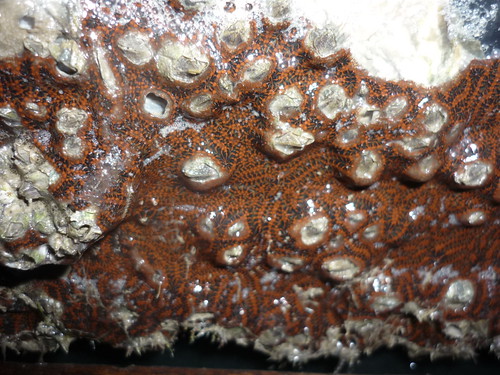
Here's a closer look.
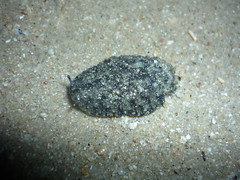

First time I've seen an onch slug (F. Onchidiidae) on this bridge. And here's a waved nerite (Nerita undata).

Common whelks (Nassarius livescens ) live up to their name, being easy to spot even on Siloso Beach itself.

I'm seeing this trend where some species that prefer the silty, muddier northern shores of Singapore can be found in the similar conditions of these artificial lagoons. This spotted moon crab (Ashtoret lunaris), which we normally find on Changi, is one such example.
Note to self: Moon crabs are extremely feisty, and if you try to catch them, they will pinch. HARD.
I finally crossed the bridge and ended up on the islet. There was some rustling in the bushes, and several times, I managed to spot rats (Rattus sp.) scampering in the shadows. That could be a reason why I couldn't find any land hermit crabs (Coenobita sp.). Some parts of the beach were covered with tiny balls of sand surrounding small round holes in the ground, telltale signs of sand bubbler crab (Scopimera sp.) activity. Larger burrows at the high shore hinted at the presence of a sizeable population of ghost crabs (Ocypode ceratophthalmus).

I've never found any moon snails (F. Naticidae) here before, but sand collars, which are the egg masses of these predatory molluscs, are quite commonly seen.

After a few frustrating attempts, I finally found a well-behaved purple climber crab that allowed me to get close and snap a few photos before scurrying off.

The blue swimming crab (Thalamita sp.) is commonly seen among the coral rubble on nearby Tanjung Rimau, but it seems to be found in respectable numbers among the large rocks found on both ends of the islet. This was just one out of four that I found within a small area.

Flower crabs (Portunus pelagicus) belong to the same family as swimming crabs, and juveniles of this species greatly outnumber the blue swimming crabs here.
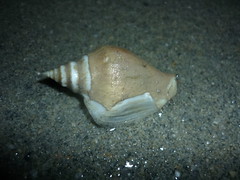

There aren't many shores where I can easily find both pearl conch (Laevistrombus canarium) and black-lipped conch (Canarium urceus).


There were a few of these blue-tailed prawns (F. Penaeidae) in the shallows, and they were quick to swim for deeper water or bury themselves. And as you can see in the second photo, it doesn't take much movement to stir up all the silt and sediment, ruining your chances of taking a decent photo.


It's impossible to miss the countless zoned horn snails (Batillaria zonalis), as well as the tiny tidal hermit crabs (Diogenes sp.) which inhabit the empty shells. I really must do a comprehensive survey of all the cerithid and potamidid snails in these lagoons and sort out which species inhabit these reclaimed beaches.
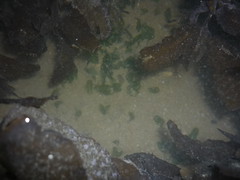
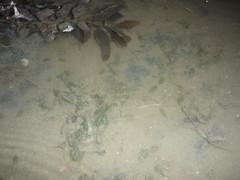
There are two tiny patches of spoon seagrass (Halophila ovalis) next to the bridge. I still remember how excited I was when I first stumbled upon the seagrass almost 2 months ago.
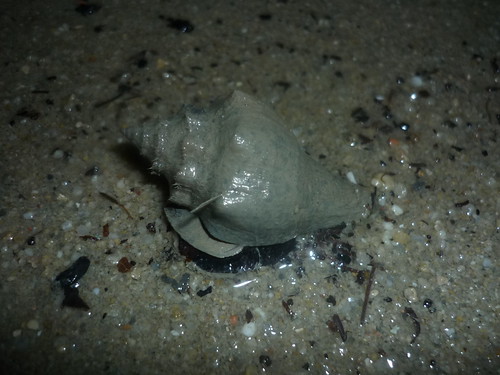
Here's another creature more commonly seen on our muddy northern shores, a spiral melongena (Pugilina cochlidium).

I was joined by two Bangladeshi workers who had come to do a bit of fishing. With a few tosses of a simple cast net, they managed to haul in quite a few fish. More on their catch in the next post.


Besides fish and random pieces of seaweed, driftwood, and assorted marine trash, the net also brought in a small elbow crab (F. Parthenopidae), as well as a blue-spined swimming crab (Thalamita sp.). I took a few photos before returning both of them to the sea.
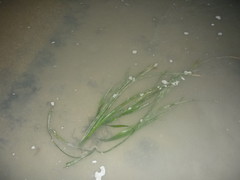
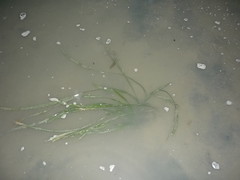
To my amazement, there was a solitary tape seagrass (Enhalus acoroides), at one end of the islet. How does it manage to get enough sunlight in these turbid waters?
I tried to find the common sea stars (Archaster typicus) that I'd found on previous visits, but despite my best efforts, I couldn't. The water was too murky to get a good view of the seabed. I hope they're all lurking in the deeper parts of the lagoon.
The tide was rising, so I crossed the bridge back to Siloso Beach.

All the flotsam, both natural and manmade, creates a disgusting frothy mess.
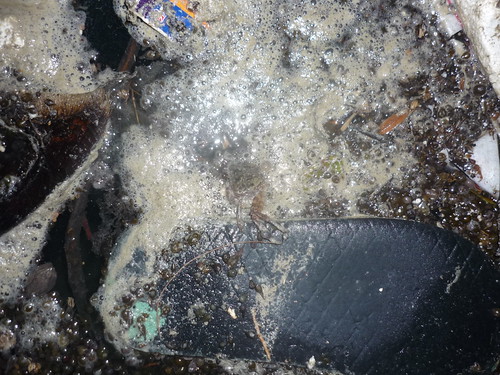
Can you see the purple climber crab trying to clamber onto the shoe?
There doesn't seem to be more rubbish than usual. Looks like the barriers did their job after all in keeping the bulk of the litter from ZoukOut out of the sea.
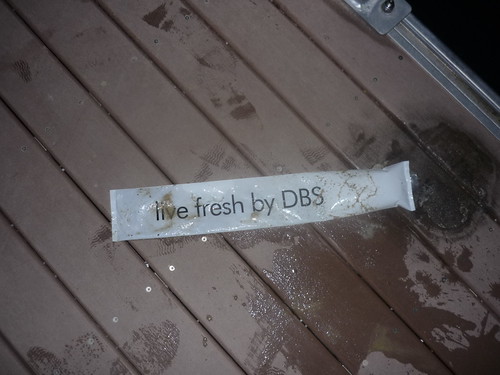
But here's one piece of rubbish that definitely came from ZoukOut. There was a booth set up by DBS that was giving out these noisemakers at ZoukOut.
I decided to go take a look at the area that was used for ZoukOut.
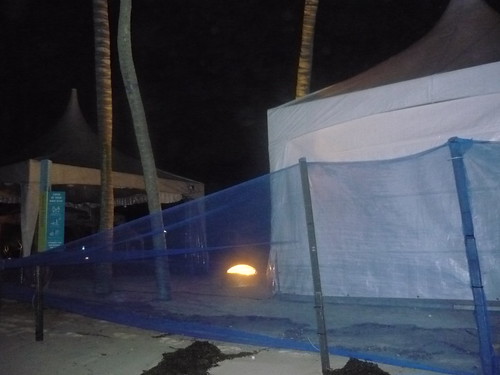
This is the blue netting that I was talking about, which not only prevented people from sneaking in and out during the event, but also provided a barrier for most of the litter.

Most of the stages and platforms have been cleared, leaving behind these tents.

The beach is all quiet now, but just three days ago, there were thousands of people crammed into this area.

Most of the litter has been removed, although there are lots of small cigarette butts half-buried in the sand. And there are some bits of trash lying on the ground. But the situation does seem a lot better than I'd feared it would be.

Just outside the barrier, I found this ghost crab, alert and skittish as ever.

I went to the toilet to wash up, and there was a red-eared slider (Trachemys scripta elegans) in the fountain!
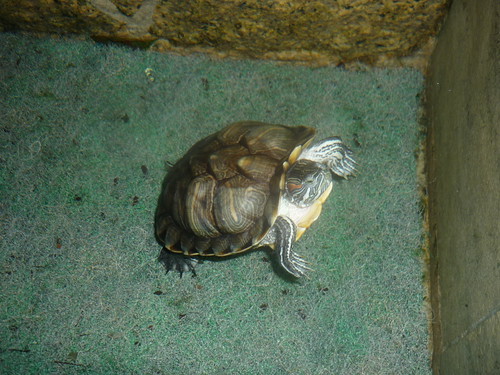
This turtle is a native of North America, and has been widely introduced to ponds, reservoirs, and canals all over Singapore. I wonder how this individual manages to find enough food to survive.
And as I walked to the Beach Station to take the Sentosa Express back to VivoCity, I passed a pond full of various species of frogs and toads, calling for mates.
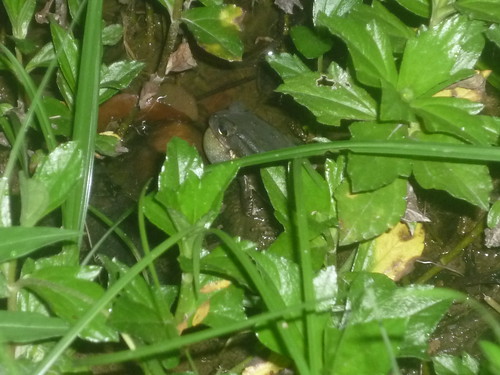
I managed to take a photo of Singapore's most common amphibian, the common Asian toad (Duttaphrynus melanostictus).
Coming up: I came upon a few very interesting fishy finds, which more than made up for the lack of sea stars.
This is part 1 of a 2-part series on a trip to Siloso Beach on 16th December, 2008.
Part 1: Siloso Surprises (this post)
Part 2: Fishy business on Siloso